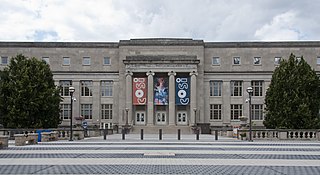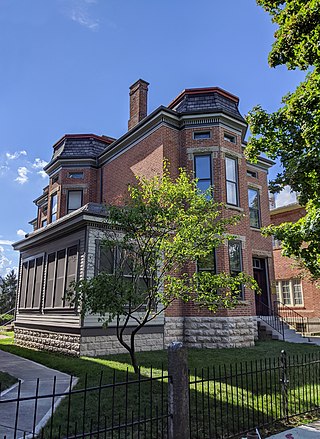
Columbus is the capital and most populous city of the U.S. state of Ohio. With a 2020 census population of 905,748, it is the 14th-most populous city in the U.S., the second-most populous city in the Midwest, and the third-most populous U.S. state capital. Columbus is the county seat of Franklin County; it also extends into Delaware and Fairfield counties. It is the core city of the Columbus metropolitan area, which encompasses ten counties in central Ohio. It had a population of 2.139 million in 2020, making it the largest metropolitan area entirely in Ohio and 32nd-largest metro area in the U.S.
Howard Dwight Smith was an architect most known for his designs of Ohio Stadium for which he was awarded the American Institute of Architects Gold Medal for Public Building Design.
The University District, is a 2.8-square-mile (7.3 km2) area located 2 miles (3.2 km) north of Downtown Columbus, Ohio that is home to the main campus of Ohio State University, the Battelle Institute, and Wexner Medical Center. It is generally accepted as the area bounded to the north by Clintonville at Glen Echo Ravine; to the south by the Short North at 5th Avenue; to the west by the Olentangy River and to east by the Conrail railroad tracks. Points of interest include, but are not limited to, the Ohio Stadium and Old North Columbus. The district is Columbus' most densely populated area and contains more than 650 businesses, human service agencies, churches, and schools. University District businesses include boutiques, mixed retail, several tattoo studios, the Gateway Film Center, and a diverse range of restaurants and bars.

Columbus City Schools, formerly known as Columbus Public Schools, is the official school district for the city of Columbus, Ohio, and serves most of the city. The district has 46,686 students enrolled, making it the largest school district in the state of Ohio as of June 2021. At its peak during the 1971 school year the district served 110,725 students.

Downtown Columbus is the central business district of Columbus, Ohio. Downtown is centered on the intersection of Broad and High Streets, and encompasses all of the area inside the Inner Belt. Downtown is home to most of the tallest buildings in Columbus.
Columbus, the state capital and Ohio's largest city, has numerous neighborhoods within its city limits. Neighborhood names and boundaries are not officially defined. They may vary or change from time to time due to demographic and economic variables.

Graham Elementary and Middle School is a public K-8 charter school in Columbus, Ohio. It was originally the Indianola Junior High School, the first junior high school in the United States. The building was owned by the Columbus City Schools, though it became operated by the Graham Family of Schools, and was sold to the organization in 2017. 2009 was the middle school's centennial year. Shortly thereafter, the school board closed that building for the 2010 school year and merged the school with the former Indianola Alternative School.

Old North Columbus is a neighborhood located just north of the Ohio State University in Columbus, Ohio. It was founded in 1847 where, at the time, it was a stand-alone city out of the confines of Columbus until it was incorporated into the City of Columbus in 1871. In its early years the city was a popular stagecoach stop with people traveling from Worthington to Columbus. Today Old North Columbus is popular for its local music and its unique "untouched architecture", which is reminiscent of its old roots.

Glen Echo is a neighborhood located in the far northern part of the University District in Columbus, Ohio. The area was listed on the National Register of Historic Places in 1997. The name Glen Echo refers to Glen Echo Ravine, which runs along the northern edge of the neighborhood. Principal streets in the area are Glen Echo Drive, Summit Street, Glenmawr Avenue, North Fourth Street, Arcadia, Cliffside Drive, and more. One street, Parkview Drive, was platted in the ravine basin, but was later abandoned.

Indianola Park was a trolley park that operated in Columbus, Ohio's University District from 1905 to 1937. The amusement park was created by Charles Miles and Frederick Ingersoll, and peaked in popularity in the 1910s, entertaining crowds of up to 10,000 with the numerous roller coasters and rides, with up to 5,000 in the massive pool alone. The park was also the home field for the Columbus Panhandles for half of a decade. In the 1920s, new owners bought and remodeled the park, and it did well until it closed at the end of the Great Depression.

Central High School, also known as High School of Columbus and High School of Commerce, was a four-year secondary school located in Franklinton, Columbus, Ohio. It was a part of Columbus City Schools. On March 7, 1985, the 1924 school building was added to the National Register of Historic Places. It is considered part of the Columbus Civic Center Historic District.

Florence Kenyon Hayden Rector (1882–1973) is known as the first licensed female architect in the state of Ohio, entering Ohio State University in 1901. She was also the only female architect practicing in central Ohio between 1900 and 1930. She was also active in the women's suffrage movement.

Weinland Park is a neighborhood north of downtown Columbus, Ohio and encompassed by the boundaries of the University District. A development boom in the 1930s and 1940s resulting from new streetcar lines and the blossoming of factories brought working and middle-class families to the neighborhood. Current housing stock consists primarily of single family residential buildings that have been converted to rentals or multifamily housing. Row-homes and apartment buildings are also ubiquitous in the neighborhood. Renters currently outnumber owners. Commercial and entertainment facilities are concentrated on the North High Street corridor, but also pocket the inner part of the neighborhood as well. Weinland Park saw the sapping of its population and wealth with the rise of newer suburbs ringing the outer reaches of the city and the collapse of local industry and streetcar lines. The neighborhood has been plagued with crime and drug problems for decades but has recently seen a flood of new investment that has brought growth and revitalization to this long struggling neighborhood. Investment into the community includes the South Campus Gateway providing retail and residential finished in 2005, and a new food district and employment center.

Franklin Park is a neighborhood located on the Near East Side of Columbus, Ohio. Both the historic neighborhood and landmark, the Franklin Park Conservatory and Botanical Gardens, are named after the 88-acre park.
The Metro Schools are a semi-public network of three schools located in Columbus, Ohio, United States, on Ohio State University's campus: Metro Early College High School (MECHS), and Metro Middle School (MECMS). The Metro Institute of Technology, the third branch of the school, closed in 2017.

Public transit has taken numerous forms in Columbus, the largest city and capital of Ohio. Transit has variously used passenger trains, horsecars, streetcars, interurbans, trolley coaches, and buses. Current service is through the Central Ohio Transit Authority's bus system, numerous intercity bus companies, and through bikeshare, rideshare, and electric scooter services.

The Columbus Landmarks Foundation, known as Columbus Landmarks, is a nonprofit historic preservation organization in Columbus, Ohio. The foundation is best-known for its list of endangered sites in the city and its annual design award, given to buildings, landscapes, and other sites created or renovated in Columbus. It was established in 1977 as a project of the Junior League of Columbus, Ohio, following the demolition of the city's historic Union Station. It is headquartered at 57 Jefferson Avenue, a contributing structure in the Jefferson Avenue Historic District in Downtown Columbus.

Southwood Elementary School is a public elementary school in Columbus, Ohio, part of Columbus City Schools. The school building, located in the city's Merion Village neighborhood, was completed in 1894 and was designed by David Riebel. It was added to the Columbus Register of Historic Properties in 2002.

120 S. Central Avenue is a former school building in the Franklinton neighborhood of Columbus, Ohio. The building was built for the West High School, and later served as Starling Middle School and Starling Elementary School. The building was added to the National Register of Historic Places and Columbus Register of Historic Properties in 2022.



















